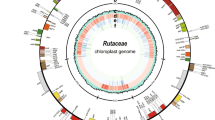Abstract
Tulbaghia violacea, called ‘wild garlic’, is a native of Africa, though it is widely cultivated all over the world for its medicinal and horticultural importance. Absence of the genus from Indian floras and taxonomic surveys, as well as lack of proper molecular and cytogenetic characterizations, have instigated questions regarding origin and divergence of the Indian counterpart from its African relatives. In the present study, morphotaxonomical identification of Indian T. violacea was carried out, along with its karyomorphological characterization, 2C nuclear genome content determination, and analysis of ITS sequence. Mitotic study revealed that this species possessed 2n = 2x = 12 somatic chromosomes, two of which had secondary constrictions, whereas unstable meiotic chromosomal behavior was observed in flower buds, as reported earlier. 2C nuclear DNA content of T. violacea (44.51 ± 0.06 pg) was reported for the first time using flow cytometry, as was the ITS sequence data, from India.



Similar content being viewed by others
References
Angiosperm Phylogeny Group [APG III]. An update of the Angiosperm Phylogeny Group classification for the orders and families of flowering plants: APG III. Bot J Linn Soc. 2009;161:105–21.
Altschul SF, Gish W, Miller W, Myers EW, Lipman DJ. Basic local alignment search tool. J Mol Biol. 1990;215:403–10.
Benham S. Tulbaghia: a survey of the species in cultivation. Plantsman. 1993;15:89–110.
Bennett MD. Nuclear DNA content and minimum generation time in herbaceous plants. Proc R Soc Lond (Biol). 1972;181:109–35.
Blattner FR. Direct amplification of the entire ITS region from poorly preserved plant material using recombinant PCR. Biotechniques. 1999;27:1180–6.
Burbidge RB. Cytotaxonomic studies in the genus Tulbaghia. Ph.D. Dissertation, The University of Edinburgh, Edinburgh, United Kingdom; 1970.
Doležel J, Sgorbati S, Lucretti S. Comparison of three DNA fluorochromes for flow cytometric estimation of nuclear DNA content in plants. Physiol Plant. 1992;85:625–31.
Doležel J, Bartoš J. Plant DNA flow cytometry and estimation of nuclear genome size. Ann Bot. 1995;95:99–110.
Doležel J, Bartoš J, Voglmayr H, Greilhuber J. Nuclear DNA content and genome size of trout and human. Cytometry. 2003;51:127–8.
Doyle J, Doyle JL. Genomic plant DNA preparation from fresh tissue—CTAB method. Phytochem Bull. 1987;19:11–5.
Dutta M, Bandyopadhyay M. Karyomorphological study and report of B chromosome in Allium griffithianum Boiss. from India. Nucleus. 2014;57:209–13.
Greilhuber J. ‘Self-tanning’—a new and important source of stoichiometric error in cytophotometric determination of nuclear DNA content in plants. Plant Syst Evol. 1988;158:87–96.
Harvey WH. Tulbaghia violacea. Violet-flowered Tulbaghia. Bot Mag. 1837;64:t.3555.
Huang X, Madan A. CAP3: a DNA sequence assembly program. Genome Res. 1999;9:868–77.
http://www.ncbi.nlm.nih.gov/genbank. Accessed 10 Jul 2016.
Ingle J, Timmis JN, Sinclair J. Relationship between satellite deoxyribonucleic acid, ribosomal ribonucleic acid gene redundancy, and genome size in plants. Plant Physiol. 1975;55:496–501.
Lakshmi N. Spontaneous chromosome breakage and inversion heterozygosity in a clone of Tulbaghia violacea Harv. Cytologia. 1988;53:157–61.
Lyantagaye SL. Ethnopharmacological and phytochemical review of Allium species (sweet garlic) and Tulbaghia species (wild garlic) from Southern Africa. Tanzan J Sci. 2011;37:58–72.
Mookerjea A. Cytology of Amaryllids as an aid to the understanding of evolution. Caryologia. 1955;7:1–71.
Sadhu A, Bhadra S, Bandyopadhyay M. Novel nuclei isolation buffer for flow cytometric genome size estimation of Zingiberaceae: a comparison with common isolation buffers. Ann Bot. 2016;118:1057–70.
Stafford GI, Wikkelsø MJ, Nancke L, Jäger AK, Möller M, Rønsted N. The first phylogenetic hypothesis for the Southern African endemic genus Tulbaghia (Amaryllidaceae, Allioideae) based on plastid and nuclear DNA sequences. Bot J Linn Soc. 2016;181:156–70.
Vosa CG. A revised cytotaxonomy of the genus Tulbaghia. Caryologia. 2000;53:83–112.
Acknowledgements
Authors acknowledge the Young Scientist Project, Science and Engineering Research Board, Department of Science and Technology, Government of India, for financial assistance. Dr. Jaroslav Doležel (Laboratory of Molecular Cytogenetics and Cytometry, Institute of Experimental Botany, Czech Republic) is acknowledged for his kind contribution with flow cytometry standard plant seeds. The Director, Centre for Research in Nanoscience & Nanotechnology (CRNN), University of Calcutta is acknowledged for providing BD FACSVerse™ Flow Cytometer instrument used in this study.
Author information
Authors and Affiliations
Corresponding author
Rights and permissions
About this article
Cite this article
Sadhu, A., Bhadra, S. & Bandyopadhyay, M. Characterization of Tulbaghia violacea (Tulbaghieae, Allioideae, Amaryllidaceae) from India: a cytogenetic and molecular approach. Nucleus 61, 29–34 (2018). https://doi.org/10.1007/s13237-017-0202-y
Received:
Accepted:
Published:
Issue Date:
DOI: https://doi.org/10.1007/s13237-017-0202-y




